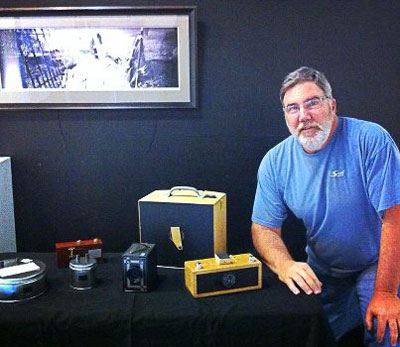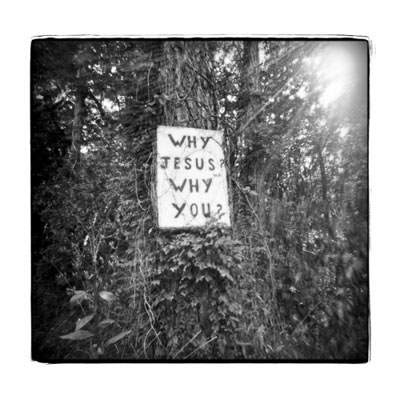On Monday, March 11, 2013, Linda and I went down the road to Charleston, SC, to attend a lecture on pinhole photography by Kevin Parent at the Charleston Center for Photography at 654 King Street for their 2nd Monday Lecture Series. It’s free and open to the public and unknown to us they hand out tickets and hold a raffle for photography swag after the lecture, but no one was there for the swag.
Wikipedia describes a pinhole camera as: A pinhole camera is a simple camera without a lens and with a single small aperture (a pin hole in the box) – effectively a light-proof box with a small hole in one side. Light from a scene passes through this single point and projects an inverted image on the opposite side of the box (w/film or photo paper inside). The human eye in bright light acts similarly, as do cameras using small apertures.
They had a pretty big crowd there, bigger than I expected, bigger than most lectures I’ve attended at some bigger institutions. Photography by nature is a loner sport, but photographers are also very social when it comes to talking about photography.
Why were we there? Good question. Did Linda or I have interest in taking up pinhole photography? Was it because of our standing in the Charleston photography community? We came for support of the speaker.
I’ve known Parent since the days when I delivered our printed paper to Carolina Fine Paintings & Prints on King Street, where he had a job as a framer – back in the day. Our connection was that we were old schoolers – as far as photography goes. But at that time Linda and I were well out of photography. Not many people in Charleston today know our photography background – we have no standing. I’ve run into Parent at photography exhibits and shared photography related info on Facebook. He’s active – we’re not. We now have an arts newspaper or it has us.
I’m reminded of how removed we are from photography as I reach down to the bottom drawer of my desk and pull out a roll of Ilford FP4 120 film with an expiration date of June 1990 and I no longer have a camera that uses 120 film – haven’t for almost 30 years. In that drawer is also the last “real” camera I own – a Nikon Nikkormat EL – which has a good layer of dust on it. There is also a roll of Kodachrome 64 with a date of 1999 that I’m holding for singer Paul Simon. I also have a drawer of about a half dozen digital cameras – one that stores the images on a floppy disk.
But, way back in the day – before our lives as publishers of an arts newspaper, Linda and I ran a custom black and white photo processing lab – IF Labs – the best in Charleston at the time, if I say so myself. Linda was a master printer and I was a wiz with film developing. But today, there are no signs of chemical stains on our fingers.
So we went to this lecture to support a fellow old schooler who is still doing it – the real old fashioned way. And, I don’t just give credit to anyone who boast that they are “special” because they are using film and photo paper processed in a darkroom. I’ve got no problem with digital photography, but I still judge all photography by the final product. I really don’t care how the photographer gets there – the image is still the thing. And there are still a lot of bad photographer out there, along with a lot of skilled technicians who are making ho hum images. Parent isn’t one of them. I don’t like all his images, but after last night’s lecture I respect all those – so much more – that speak to me, after learning how much he’s flying by the seat of his pants in capturing his images. Hey, here’s a news flash – this isn’t just a problem for photography. The art world is full of artists who are not yet at the top of their game. Some might get there some day – some never will.

Kevin Parent with some of his pinhole cameras
Throw in the fact that Parent makes his own cameras and you really wonder why someone still puts themselves through this old school process, but Parent explained all that in his presentation. It’s an emotional thing for him. And, you can’t beat the cost of the camera – which he makes out of just about anything.
He did say one thing that I had to differ with. It’s not that I disagree with what he said, I just see it differently. At one point he said that pinhole photography is the only way to stop nature and capture it in an image. You can’t do it with a shutter speed of 1/500th of a second, but I think he was referring to the fact that pinhole photography slows the photographer down, due to the nature that you have only a few shots and without a viewfinder to actually see what you are trying to capture – you really have to slow down and think about what you’re doing or trying to do. Where with today’s digital cameras you can just shoot away hoping you get something from volume – as you’re not burning up expensive film anymore. And, you can just delete what you don’t want – on the spot and shoot again and again or slip another memory disk into the camera. That might work in sports photography.
I think the technology of stop-action and high speed photography has really stopped nature – giving us a chance to see the unseeable with our human eyes. Think tiny tree frog in the Amazon jumping from one leaf to another and the camera catching it in mid-jump. Now that’s stopping nature. I prefer to think that what he meant was that pinhole photography stops nature – in motion – due to the long exposures (time the pinhole is uncovered). And, it’s a good thing that it slows the photographer down and makes them think about what they are doing. Slowing our lives down gives us a better view of nature or something like that. Let’s all break into small groups and discuss that.
Of course I had the advantage of a hour and a half ride home to come up with that and I wasn’t standing in front of an audience. It’s a point the two of us could talk about for hours and I could be wrong. It wouldn’t be the first time I missed the point – as Linda tells me often enough.
But, that’s the value of going to an artist’s lecture. You get to hear what they are trying to do, what’s in their head and how they feel about the work they produce. It’s a lot better than standing in front of an image and just trying to figure things out or reading a page or two about what the artist meant to do in presenting their image. Or, the artist who says it’s all up to the individual viewer – it’s what it means to the viewer – that’s all they care about. That’s true, but that’s just as bad as the people trying to figure out what the Beatles meant by every word they wrote – even playing songs backwards to find the “true” meaning of their songs. I prefer William Halsey’s (one of Charleston’s best artists) answer when asked by viewers what he meant by his paintings – “What does it mean?” – “it means I finished!” But, it’s not that simple either. A lecture gets you a little closer to your understanding if the artists was successful in their goals – if they had any to begin with. It’s one more step in the process of understanding. Or you could just go with the process of deciding if you just like something or not. Oh my head is beginning to hurt. Art speak will get you every time.
The Charleston Center for Photography will have a small exhibit of Parent’s works up on view through the end of the month. You can also see his work at the Corrigan Gallery on Queen Street in downtown Charleston and on his website at (www.kevinbruceparent.com).
Parent will also conduct a workshop on pinhole photography later this month. For info call the Charleston Center for Photography at 843/720-3105.
The next 2nd Monday Lecture Series will take place at 7pm on April 8, 2013, and be presented by Stephanie Coakley. Check the Center for details.


